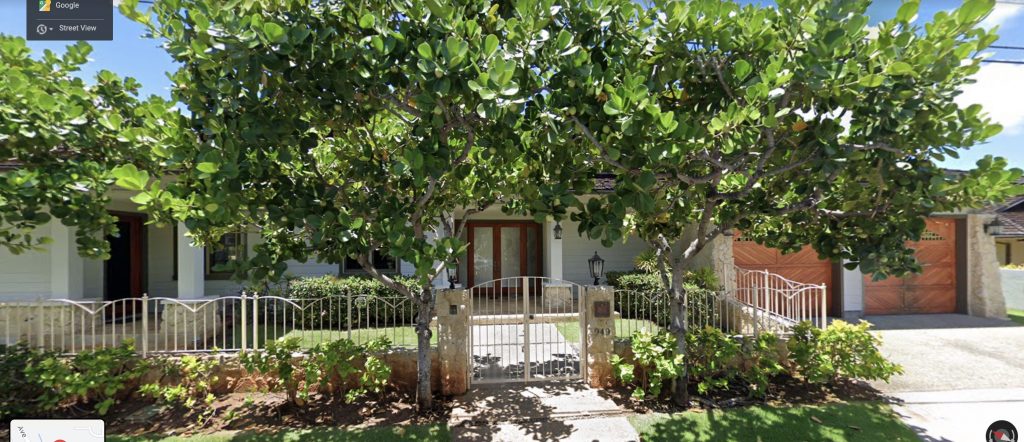I’ve been frustrated for the past week, finding lots of “dots” without being able to figure out what the picture will look like when the dots are finally connected.
Here’s an example.
You may recall that back in April, police officers responding to a 911 call shot and killed a 29-year old from South Africa, Lindani Myeni, outside a home at 91 Coelho Way in lower Nuuanu.
It still isn’t clear what Myeni was doing at the home, or why he attacked the responding officers.
State real property records show the current registered owner of the property is James H. Hall, a former contractor who moved to Hawaii from Wisconsin with his wife and four children at the beginning of 2009, after his business had gone bankrupt and their home was lost through foreclosure.
Records show Hall purchased Greentree Properties LLC, a Nevada company that held title to the Coelho Way property, in September 2018 from Honolulu attorney Gary Dubin, who has since been disbarred by the Hawaii Supreme Court. Three months later, Hall transferred title in the property from Greentree to himself.
A week after the fatal shooting, the Honolulu Star-Advertiser reported the home had previously been the subject of complaints about illegal short-term rentals.
In 2019 and 2020 the city Department of Planning and Permitting investigated seven complaints that 91 Coelho Way was being used as an illegal short-term rental. Rentals of fewer than 30 days are not allowed at the property, said DPP spokesman Curtis Lum.
In addition, according to the Star-Advertiser, police officers also responded to several other incidents at the home, including a car break-in, a possible COVID violation, a car accident, and a “miscellaneous incident.”
However, the complaints led to a dead end.
“Our investigation determined that the ads were for 30 days or more, which is not a violation,” Lum told Star-Advertiser reporter Peter Boylan. “On-site inspections of the property did not reveal an illegal short-term rental on this property.”
End of story? Apparently not.
What wasn’t known at the time is that the Hall applied for and received received four federal Payroll Protection Program loans during 2020 and 2021 that totaled over $215,000, including two that classed his businesses as operating a hotel or motel.
In each year, separate loans went to Greentree Properties LLC, the Nevada company owned by Hall since 2018, and to a sole proprietorship also owned by Hall, PPP loan records show.
All four loans were made by First National Bank Texas. These were the only PPP loans made by the bank in Hawaii.
Greentree received a PPP loan of $96,656 in 2021. Greentree’s loan application was approved on April 9, just two days before Myeni’s shooting. Despite applying for and receiving the PPP loan, based on a prior year’s payroll, Greentree Properties is not listed among companies registered to do business in Hawaii, state business registration records show.
Hall’s sole proprietorship received $29,165 in 2021, according to the PPP lookup at the website, FederalPay.org. Both company’s applications reported they were in an industry category for “Hotels (except Casino Hotels) and Motels.”
According to the North American Industry Classification System (NAICS):
This industry comprises establishments primarily engaged in providing short-term lodging in facilities known as hotels, motor hotels, resort hotels, and motels. The establishments in this industry may offer food and beverage services, recreational services, conference rooms, convention services, laundry services, parking, and other services.
FederalPay.org examined loan eligibility criteria, and estimated the annual payroll of $464,000 was required to qualify for the loan awarded to Greentree Properties in 2021.
The size of company’s PPP loan indicates that the number of employees on payroll during the eligibility calculation period (typically 2019) was higher than the 4 jobs reported as retained on the PPP application3. This could be caused by a reduction in employment since 2019, due to Coronavirus or other factors.
The minimum number of employees this company must have had in 2019 to qualify for the loan range received is 5. This estimation is accurate if all employees were paid at or over the $100k PPP salary eligibility cap….
Based on the standard PPP eligibility formula, it may be possible to estimate the payroll expenses represented by a company on their PPP application (see details above). In order to qualify for the PPP loan amount received, Greentree Properties LLC’s 2019 payroll expenses are estimated to be at least $463,949 (not accounting for salary amounts > $100k).
In the earlier round of PPP loans distributed in 2020, Hall received a loan of $20,800, while Greentree received a loan of $69,000. Both companies listed themselves in a different category, this one defined as “other services to buildings and dwellings.”
“This industry comprises establishments primarily engaged in providing services to buildings and dwellings (except exterminating and pest control; janitorial; landscaping care and maintenance; and carpet and upholstery cleaning),” according to the NAICS definition.
Examples of the types of services in this category include building exterior cleaning services (except sandblasting, window cleaning), swimming pool cleaning and maintenance services, chimney cleaning services, ventilation duct cleaning services, and drain or gutter cleaning services.
Greentree Properties LLC, a Nevada limited liability company, had been established in 2007 by former Honolulu attorney Gary Victor Dubin to hold title to the Coelho Way property. Dubin had sole control of Greentree from 2007 until September 2018, when he reportedly sold his interest in the company to Hall, court records show.
Then on November 26, 2018, Hall, now acting as the sole member of Greentree, executed a quit-claim deed transferring title to the Coelho Way property from the company to himself personally. Honolulu real property records now list Hall as the property’s sole owner.

